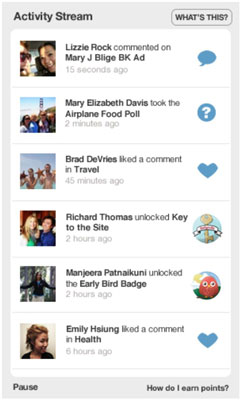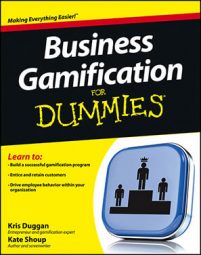The social loyalty framework is ideal for engaging the masses or converting one-time customers into returning ones. The social loyalty framework rewards your site’s users for what they already do, their valued gameplay behaviors. With the social loyalty framework, you can apply any number of mechanics within the framework of the gamified site.
You can apply pretty much any game mechanic with this framework. Here are the various mechanics available to you:
Points: Points allow users to compare disparate activities and reveal the relative value of gameplay activities. These points can then be compiled into a score, which acts as a measure of progress, success, and the like.
Setting limits on points is a good idea if the gameplay behavior those points reward is exploitable. For example, you might limit the number of times a person can earn points for a given behavior on a daily or weekly basis to prevent users from gaming your site.
Leaderboards: A leaderboard both shows users where they rank and boosts the desire to “play” in order to rise up through the ranks. Those at the top enjoy the notoriety such accomplishment brings; as for everyone else, the leaderboard shows them where they stand relative to their peers. The bottom line? People like to keep score — and a leaderboard enables them to do that.
Levels: Levels indicate progress and convey status. That is, a player who has reached level 21 can reasonably be considered of a higher status than someone who has failed to advance beyond level 4. Typically, users advance to a new level in a gamified system when they earn a certain number of points.
Missions: A mission requires users to perform a prescribed set of actions, following a guided path of your design. Sometimes, the actions in a mission must occur in a certain order. Other times, they can occur in any order.
Feedback: Feedback refers to the broadcast of real-time notifications when users perform a desired gameplay behavior, level-up, unlock a reward, and so on. Another type of feedback is an activity feed, which enables users to see what others on the site or app are doing at the site. This feedback keeps players from feeling paralyzed, as if they’re making no progress.

Achievements and rewards: These provide positive reinforcement for high-value gameplay behaviors. Rewards can be divided into three categories: recognition, privileges, and monetary rewards.
In the social loyalty framework, you can easily leverage all types of rewards. In the social loyalty framework, rewards can be either hierarchical or standalone. If they’re hierarchical, value and difficulty should increase along the hierarchy. If they’re standalone, you should take care to award points according to difficulty.

